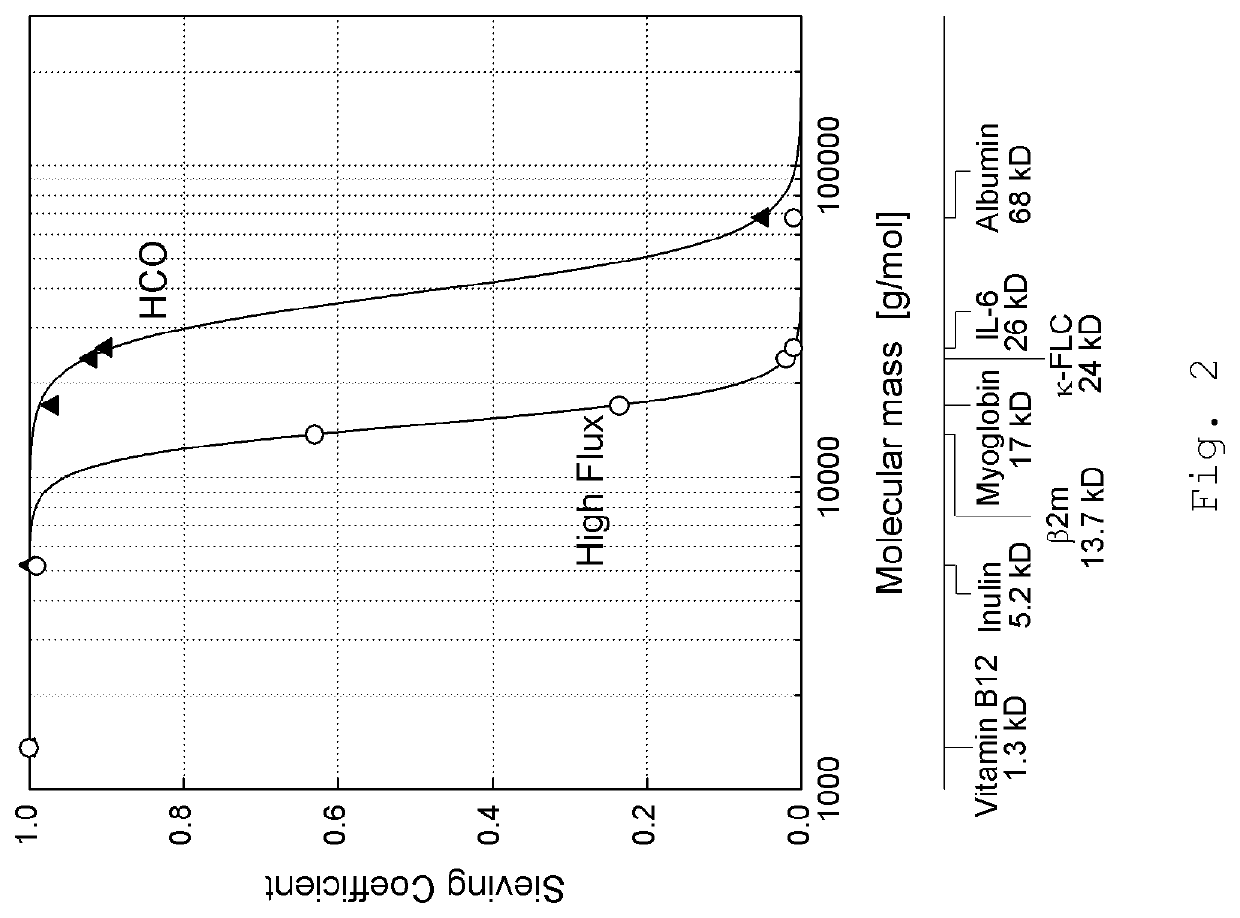High cut-off hemodialysis membrane for use in liver dialysis
a hemodialysis membrane and high-cutting technology, applied in the field of liver dialysis system, can solve the problems of coagulation problems during treatment sessions, inapplicability of established kidney dialysis methods alone, accumulation of toxins not cleared by the failing liver,
- Summary
- Abstract
- Description
- Claims
- Application Information
AI Technical Summary
Benefits of technology
Problems solved by technology
Method used
Image
Examples
example 1
HSA Concentration in the System
[0076]It was the goal of the present experiment to monitor the development of the HSA concentration within the liver support system. The development of the HSA concentration is of interest, as the High Cut-off dialysis membrane allows, to a certain extent, the passage of albumin (see also Table 1). For this test a standard MARS system with an AK95 / MARS Monitor were used, in combination with a 2.1 m2 High Cut-off dialysis membrane, hereinafter referred to as P5SH (FIG. 1 (3)). The P5SH dialyzer is equivalent to the HCO 1100® dialyzer, with the exception of the membrane area which is smaller in the HCO 1100® version. The P5SH filter was used to have a membrane area which is equivalent to the conventional MARSFlux® filter membrane area. Further, a diaFlux 1.4 filter (FIG. 1 (4)) was used. The activated carbon adsorber was AC 250 AE, the anion exchanger was IE 250. Unconjugated bilirubin was from Sigma (EC 211-239-7). Bile acid (chenodeoxycholic acid) was ...
example 2
Bilirubin Reduction
[0084]Tests were done as described in Example 1. The albumin concentration was again 5% and 10%. The concentration of unconjugated bilirubin was determined in samples taken at Bin. FIG. 5 A depicts the development of the bilirubin concentration in the blood circuit when the HSA concentration in the albumin circuit is 10% at 0 min. FIG. 5 B depicts the development of the bilirubin concentration in the blood circuit when the HSA concentration in the albumin circuit is 5% at 0 min. As can be seen, the bilirubin concentration decreases in both system settings. The reduction rate is about 47% in both cases.
example 3
Bile Acid Reduction
[0085]Tests were done as described in Example 1. The albumin concentration was again 5% and 10%. The concentration of bile acid was determined in samples taken at Bin. FIG. 6 A depicts the development of the bile acid concentration in the blood circuit when the HSA concentration in the albumin circuit is 10% at 0 min. FIG. 6 B depicts the development of the bile acid concentration in the blood circuit when the HSA concentration in the albumin circuit is 5% at 0 min. As can be seen, the bile acid concentration decreases in both system settings. The reduction rate is about 83% at a HSA concentration of 10% and 87% at a HSA concentration of 5%.
PUM
| Property | Measurement | Unit |
|---|---|---|
| diameter | aaaaa | aaaaa |
| diameter | aaaaa | aaaaa |
| molecular weight | aaaaa | aaaaa |
Abstract
Description
Claims
Application Information
 Login to View More
Login to View More - R&D
- Intellectual Property
- Life Sciences
- Materials
- Tech Scout
- Unparalleled Data Quality
- Higher Quality Content
- 60% Fewer Hallucinations
Browse by: Latest US Patents, China's latest patents, Technical Efficacy Thesaurus, Application Domain, Technology Topic, Popular Technical Reports.
© 2025 PatSnap. All rights reserved.Legal|Privacy policy|Modern Slavery Act Transparency Statement|Sitemap|About US| Contact US: help@patsnap.com



